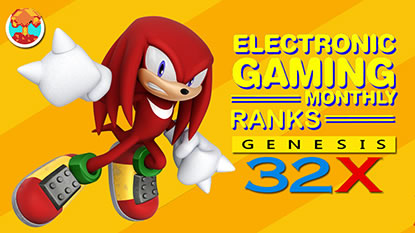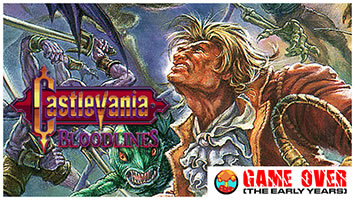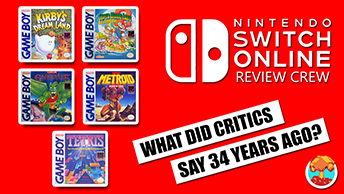- CLASSIC MAGAZINES
- REVIEW CREW
A show recapping what critics thought back
when classic games first came out! - NEXT GENERATION'S BEST & WORST
From the worst 1-star reviews to the best
5-stars can offer, this is Next Generation! - NINTENDO POWER (ARCHIVE)
Experience a variety of shows looking at the
often baffling history of Nintendo Power! - MAGAZINE RETROSPECTIVE
We're looking at the absolutely true history of
some of the most iconic game magazines ever! - SUPER PLAY'S TOP 600
The longest and most ambitious Super NES
countdown on the internet! - THEY SAID WHAT?
Debunking predictions and gossip found
in classic video game magazines! - NEXT GENERATION UNCOVERED
Cyril is back in this spin-off series, featuring the
cover critic review the art of Next Generation! - HARDCORE GAMER MAGAZING (PDF ISSUES)
Download all 36 issues of Hardcore Gamer
Magazine and relive the fun in PDF form!
- REVIEW CREW
- ELECTRONIC GAMING MONTHLY
- ELECTRONIC GAMING MONTHLY RANKS
From Mario to Sonic to Street Fighter, EGM
ranks classic game franchises and consoles! - ELECTRONIC GAMING MONTHLY BEST & WORST
Counting down EGM’s best and worst reviews
going year by year, from 1989 – 2009! - ELECTRONIC GAMING BEST & WORST AWARDS
11-part video series chronicling the ups and
downs of EGM’s Best & Worst Awards!
- ELECTRONIC GAMING MONTHLY RANKS
- GAME HISTORY
- GAME OVER: STORY BREAKDOWNS
Long-running series breaking down game
stories and analyzing their endings! - A BRIEF HISTORY OF GAMING w/ [NAME HERE]
Real history presented in a fun and pithy
format from a variety of game historians! - THE BLACK SHEEP
A series looking back at the black sheep
entries in popular game franchises! - INSTANT EXPERT
Everything you could possibly want to know
about a wide variety of gaming topics! - FREEZE FRAME
When something familiar happens in the games
industry, we're there to take a picture! - I'VE GOT YOUR NUMBER
Learn real video game history through a series
of number-themed episodes, starting at zero! - GREAT MOMENTS IN BAD ACTING
A joyous celebration of some of gaming's
absolute worst voice acting!
- GAME OVER: STORY BREAKDOWNS
- POPULAR SHOWS
- DG NEWS w/ LORNE RISELEY
Newsman Lorne Riseley hosts a regular
series looking at the hottest gaming news! - REVIEW REWIND
Cyril replays a game he reviewed 10+ years
ago to see if he got it right or wrong! - ON-RUNNING FEUDS
Defunct Games' longest-running show, with
editorials, observations and other fun oddities! - DEFUNCT GAMES QUIZ (ARCHIVE)
From online quizzes to game shows, we're
putting your video game knowledge to the test!- QUIZ: ONLINE PASS
Take a weekly quiz to see how well you know
the news and current gaming events! - QUIZ: KNOW THE GAME
One-on-one quiz show where contestants
find out if they actually know classic games! - QUIZ: THE LEADERBOARD
Can you guess the game based on the classic
review? Find out with The Leaderboard!
- QUIZ: ONLINE PASS
- DEFUNCT GAMES VS.
Cyril and the Defunct Games staff isn't afraid
to choose their favorite games and more! - CYRIL READS WORLDS OF POWER
Defunct Games recreates classic game
novelizations through the audio book format!
- DG NEWS w/ LORNE RISELEY
- COMEDY
- GAME EXPECTANCY
How long will your favorite hero live? We crunch
the numbers in this series about dying! - VIDEO GAME ADVICE
Famous game characters answer real personal
advice questions with a humorous slant! - FAKE GAMES: GUERILLA SCRAPBOOK
A long-running series about fake games and
the people who love them (covers included)! - WORST GAME EVER
A contest that attempts to create the worst
video game ever made, complete with covers! - LEVEL 1 STORIES
Literature based on the first stages of some
of your favorite classic video games! - THE COVER CRITIC
One of Defunct Games' earliest shows, Cover
Critic digs up some of the worst box art ever! - COMMERCIAL BREAK
Take a trip through some of the best and
worst video game advertisements of all time! - COMIC BOOK MODS
You've never seen comics like this before.
A curious mix of rewritten video game comics!
- GAME EXPECTANCY
- SERIES ARCHIVE
- NINTENDO SWITCH ONLINE ARCHIVE
A regularly-updated list of every Nintendo
Switch Online release, plus links to review! - PLAYSTATION PLUS CLASSIC ARCHIVE
A comprehensive list of every PlayStation
Plus classic release, including links! - RETRO-BIT PUBLISHING ARCHIVE
A regularly-updated list of every Retro-Bit
game released! - REVIEW MARATHONS w/ ADAM WALLACE
Join critic Adam Wallace as he takes us on a
classic review marathon with different themes!- DEFUNCT GAMES GOLF CLUB
Adam Wallace takes to the links to slice his way
through 72 classic golf game reviews! - 007 IN PIXELS
Adam Wallace takes on the world's greatest spy
as he reviews 15 weeks of James Bond games! - A SALUTE TO VAMPIRES
Adam Wallace is sinking his teeth into a series
covering Castlevania, BloodRayne and more! - CAPCOM'S CURSE
Adam Wallace is celebrating 13 days of Halloween
with a line-up of Capcom's scariest games! - THE FALL OF SUPERMAN
Adam Wallace is a man of steel for playing
some of the absolute worst Superman games! - THE 31 GAMES OF HALLOWEEN
Adam Wallace spends every day of October afraid
as he reviews some of the scariest games ever! - 12 WEEKS OF STAR TREK
Adam Wallace boldly goes where no critic has
gone before in this Star Trek marathon!
- DEFUNCT GAMES GOLF CLUB
- DAYS OF CHRISTMAS (ARCHIVE)
Annual holiday series with themed-episodes
that date all the way back to 2001!- 2015: 30 Ridiculous Retro Rumors
- 2014: 29 Magazines of Christmas
- 2013: 29 Questionable Power-Ups of Christmas
- 2012: 34 Theme Songs of Christmas
- 2011: 32 Game Endings of Christmas
- 2010: 31 Bonus Levels of Christmas
- 2009: 30 Genres of Christmas
- 2008: 29 Controls of Christmas
- 2007: 34 Cliches of Christmas
- 2006: 33 Consoles of Christmas
- 2005: 32 Articles of Christmas
- 2004: 31 Websites of Christmas
- 2003: 29 Issues of Christmas
- 2002: 28 Years of Christmas
- 2001: 33 Days of Christmas
- NINTENDO SWITCH ONLINE ARCHIVE
- REVIEW ARCHIVE
- FULL ARCHIVE
Nintendo Power
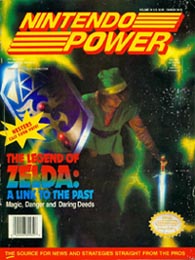
Instead of using artwork, Nintendo Power would often hire models to "look" like video game characters.
How We Got Here: For a lot of people, Nintendo Power is where it all began. By 1988 Nintendo found itself unsatisfied with reviving the video game industry after the near fatal crash of 1983; they were interested in something bigger, a loyal fan base that would rival even the most established Saturday morning cartoon. Even in the mid '80s Nintendo had enough good sense to convince young gamers that what they wanted was a 120-page advertisement every other month.
The critics can blast the magazine for being a propaganda tool pointed directly at our innocent
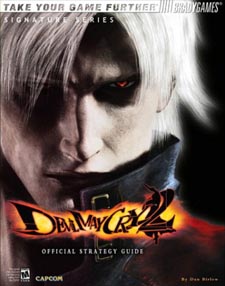
Without Nintendo Power, chances are we would not have strategy guides for the most challenging games, like Devil May Cry 2!
It's also one of the few magazines that also works as a strategy guide. Before Prima and other big companies got involved with mapping out games and making them easy enough for even the worst gamer, Nintendo was there showing them how it was done. With more than half of their magazine space devoted to huge, sprawling maps, blow-by-blow hints for boss battles, and hidden codes, Nintendo Power was in the business of making strategy guides before it was a multi-million dollar industry.
It didn't take long for Nintendo to realize that these strategy guides may actually be counter-productive. For one thing, they really only affected a small part of their fan base, and they took a lot of time to assemble. There were also only a handful of games that could really be dug into with the depth these issues wanted. And Nintendo was able to do much more advertising by doing mini-strategy guides in twelve regular issues a year. It has been monthly ever since.
Weird Tales in Marketing: Not only did Nintendo Power bring their readers monthly strategy guides, but they also attempted to give out free games. Long before magazines considered giving their readers free demos, Nintendo Power actually gave their subscribers a free copy of Dragon Warrior.
Fearing all the money and time spent translating Japanese role-playing games like Final Fantasy and Dragon Quest (which would become Dragon Warrior)
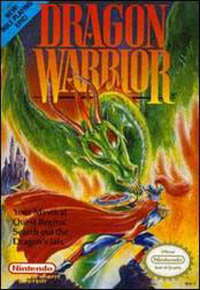
Even though there are close to ten Dragon Quest games, the original is the only one people seem to remember!
As a gimmick to help subscription sales, Nintendo dangled Dragon Warrior in front of them. They picked the Nintendo Power people, perhaps thinking they were the ones that would be able to read the game, and promised them a game that sounded a lot more exciting than it was. They hoped and prayed that it would pay off for future games in the genre. But it didn't, and most role-playing games ended up having a very quiet life in the States. It wasn't until Final Fantasy VII introduced the genre to hot graphics and amazing cinemas that people took notice.
Where The Readers Are King: Most magazines have a letters to the editor section, but Nintendo Power went one step further. From the very beginning back in the late 1980s, Nintendo Power has been set up more like a fan club than a traditional magazine. There was a sense of community, a way for gamers to get a hold of each other and explain why they are the better gamer. Heck, they even had a section for hi scores and accomplishments. That's right, Nintendo actually printed the names of people that beat Shadowgate or the Legend of Zelda!
What's more, Nintendo actually gave players a stage to brag. Every month countless Nintendo fans, usually in their early teens, yammered on about how they thought they were the ultimate gamer because they have "defeated" 12 whole games! It would be the same story every month, regardless of age or sex, the
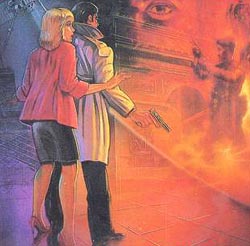
The Mafat Conspiracy is just one of the many third party games that found Nintendo Power a cold place to stay!
Waiting For That Other Shoe to Fall: write and publish your own magazine about your own games, it's hard to stay objective. While a proper review section wasn't added until well into the magazines life, its absence didn't hurt the magazine much. Hoping that the public would see past the conflict of interest, Nintendo started reviewing their games with disastrous results.
Nintendo's conflict of interest was apparent in other facets of the magazine, including how much space third party games received versus Nintendo's own titles. And their continuing ability to completely ignore their competition (never actually saying their names, even when appropriate) made more than a few question just how accurate the information was.
As other magazines started to sprout up, Nintendo Power's lack of subjective journalism started to seep through. Magazines like Game Players and Electronic Gaming Monthly gave consumers a taste of everything that was out there, while also keeping the Nintendo coverage front and center.
Memorable Quote: "I think I'm a Power Player because I've beaten just about every game that I've played. I've defeated 19 Nintendo games so far. My Game Pack library is small so half the games I defeated were borrowed from friends. Since I'm often busy with schoolwork, I cannot beat games quickly. Nevertheless, if I'm persistent enough I can beat even the most time-consuming games such as the Legend of Zelda, the Adventure of Link, and Metal Gear. The game that puzzled me the most of all the games I've defeated was Rambo. I finally solved it without any help and destroyed the flying fortress using only five life bottles." -Will Cwiertniak
FINAL GRADE: B-
HOME |
CONTACT |
NOW HIRING |
WHAT IS DEFUNCT GAMES? |
NINTENDO SWITCH ONLINE |
RETRO-BIT PUBLISHING
Retro-Bit |
Switch Planet |
The Halcyon Show |
Same Name, Different Game |
Dragnix |
Press the Buttons
Game Zone Online | Hardcore Gamer | The Dreamcast Junkyard | Video Game Blogger
Dr Strife | Games For Lunch | Mondo Cool Cast | Boxed Pixels | Sega CD Universe | Gaming Trend
Game Zone Online | Hardcore Gamer | The Dreamcast Junkyard | Video Game Blogger
Dr Strife | Games For Lunch | Mondo Cool Cast | Boxed Pixels | Sega CD Universe | Gaming Trend
Copyright © 2001-2025 Defunct Games
All rights reserved. All trademarks are properties of their respective owners.
All rights reserved. All trademarks are properties of their respective owners.













